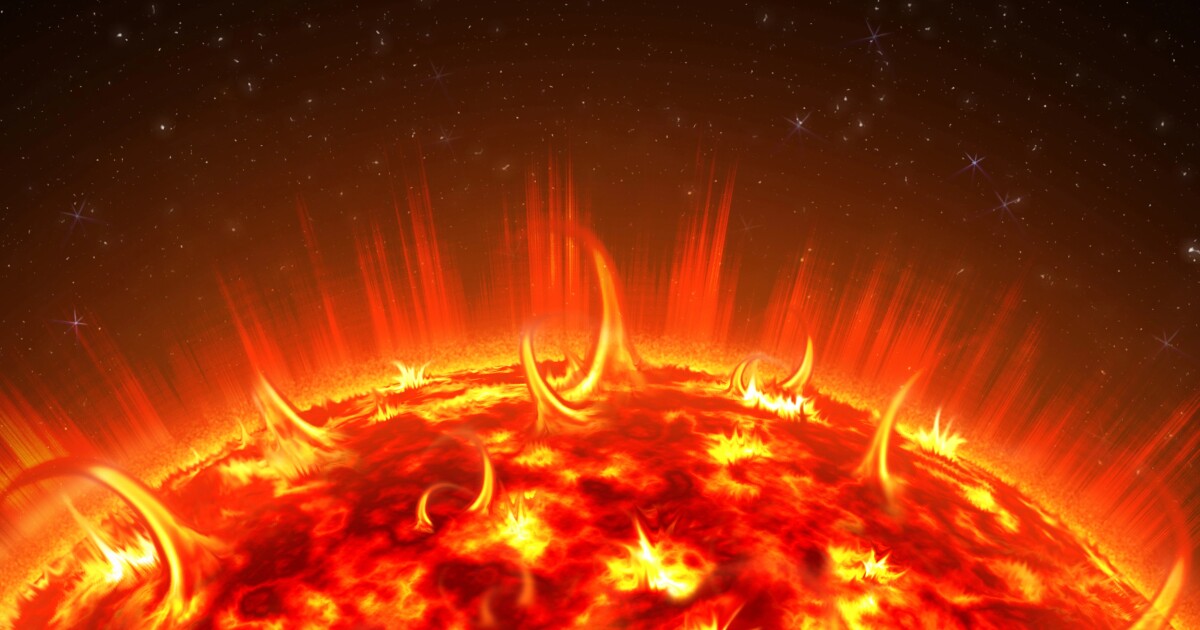Did you know it rains on the Sun? Not water, of course. It’s solar rain, which occurs in the Sun’s corona, the outermost layer composed of intensely hot plasma. This phenomenon involves cooler, heavier blobs of plasma that condense high above the Sun’s surface and then plunge back down.
For years, researchers had been unable to understand how this “rain” formed so rapidly during solar flares. Now, researchers at the University of Hawaiʻi have finally figured out why.
Radiation helps cool the plasma in the Sun’s corona. But the mix of elements in different parts of the corona isn’t fixed. It changes over time, and across regions. Most models overlook this and assume that element levels remain constant everywhere.
Because of this, these models struggle to explain rapidly changing events like solar rain, which appear during flares and in active zones. Since the amount of energy lost through radiation depends on the elements present, oversimplifying their behavior means missing the key physics behind how the solar atmosphere really works.
Luke Benavitz, a first-year graduate student working on the project, said, “At present, models assume that the distribution of various elements in the corona is constant throughout space and time, which clearly isn’t the case.”
The team discovered that shifts in the mix of elements, called elemental abundances, can explain how solar rain forms so quickly.
To better model how radiation cools the Sun’s plasma, they updated a simulation tool called HYDRAD. Instead of assuming the element mix remains constant everywhere and all the time, they allow it to vary across space and time, especially for elements with low first ionization potential (low-FIP), which play a key role in solar activity.
They even added a new equation to track how these low-FIP elements move and change. When they compared this upgraded model to the old one, the results showed a much better match with real solar rain events.
HYDRAD is a specialized simulation tool that studies how solar plasma flows along magnetic field lines, like traffic moving through a cosmic tunnel. It treats the plasma as two interacting fluids (electrons and ions) and tracks their behavior in detail.
What makes HYDRAD powerful is its complete treatment of heat and energy flow. It includes thick radiation from the Sun’s lower atmosphere (the chromosphere), heat conduction with safety checks to avoid unrealistic spikes, and thin radiation losses from the corona.
Together, these features help researchers model the Sun’s dynamic atmosphere with high precision.
The researchers demonstrated that when tracking the movement of low-FIP elements through the Sun’s atmosphere, it becomes easy to understand solar rain.
Here’s what happens: hot plasma rises from the lower layers of the Sun, a process called chromospheric evaporation, and flows along magnetic loops in the corona. Most of the loop experiences a drop in these elements, except at the very top, or apex, where their levels increase. This increase raises radiation loss right at the apex, cooling the plasma quickly and causing it to condense. That’s how solar rain forms in loops that are suddenly heated, like during flares.
Currently, no other solar model accounts for radiation while allowing element levels to change across space and time. However, these shifting spatiotemporal abundances are crucial to understanding how plasma cools in the Sun’s atmosphere and why solar rain forms.
Researchers have shown that making these changes can trigger coronal rain in simulations. By including spatiotemporal abundances, researchers are not only improving one model; they are also enhancing how radiation is handled in all magnetohydrodynamic models.
In the simulations, researchers assumed the coronal loop already had a split mix of elements, which they refer to as fractionated. But if they include a force called the ponderomotive force, they could model the loop from an earlier stage, before it gets heated.
Observations from the Hinode/EIS spacecraft support this. They found that solar rain has a complex elemental fingerprint. The rain itself showed a photospheric signature (based on the silicon-to-sulfur ratio), while the hotter plasma around it had a coronal signature (based on calcium-to-argon).
This matches what the model predicts: during chromospheric evaporation, the Si/S ratio shifts to photospheric inside the rain, while Ca/Ar stays coronal in the surrounding hot plasma. That means the rain forms through the same physics the model describes.
“It’s exciting to see that when we allow elements like iron to change with time, the models finally match what we actually observe on the Sun,” Benavitz said. “It makes the physics come alive in a way that feels real.”
Co-author Jeffrey Reep added, “This discovery matters because it helps us understand how the Sun really works. We can’t directly see the heating process, so we use cooling as a proxy. But if our models haven’t treated abundances properly, the cooling time has likely been overestimated. We might need to go back to the drawing board on coronal heating, so there’s a lot of new and exciting work to be done.”
The study was published in the journal The Astrophysical Journal.
Source: University of Hawaii at Manoa via ScienceDaily







